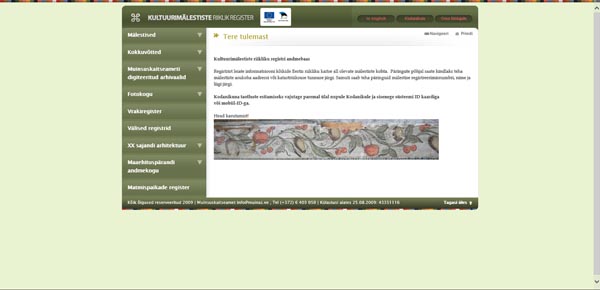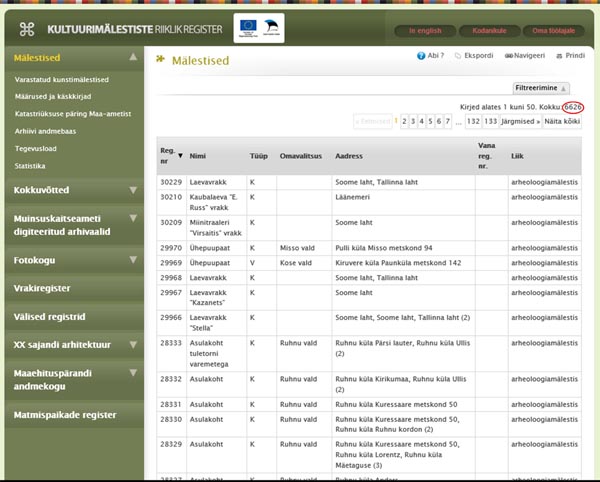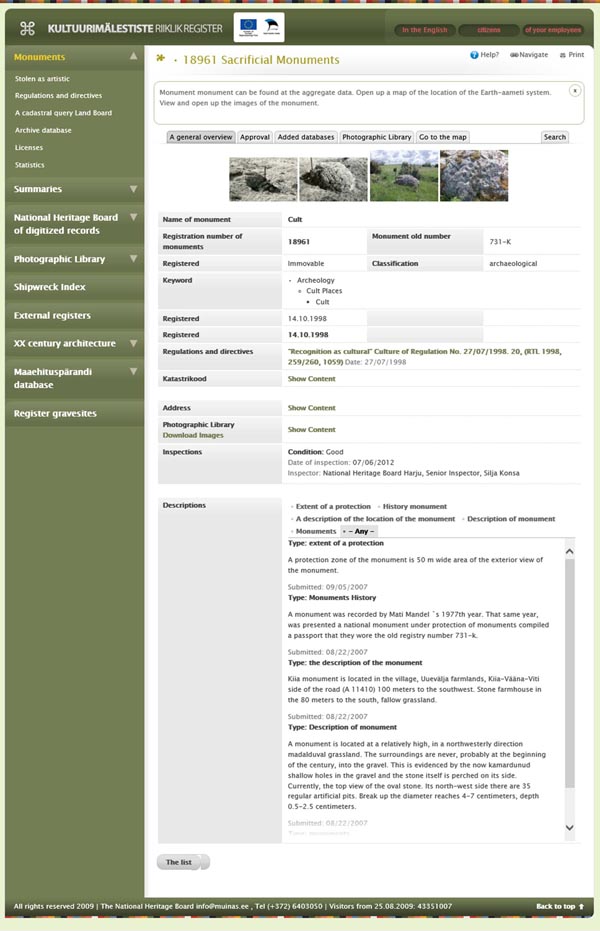

| Vol. XXVII, No. 1 — April, 2014 |
Articles in Vol. XXVII, No. 1
Reading on the Web
New systems bring simpler approaches.
-- Andrea Vianello
Digital Data — Ur of the Chaldees: Making a Virtual Vision Possible
Making old information fit the modern world.
-- William B. Hafford
Website Review: National Register of Cultural Monuments (of Estonia)
An exemplar for a national cultural database.
-- Andrea Vianello
Preserving Photographs
The ADS is already doing this.
-- Harrison Eiteljorg, II
The Time Has Come: CSA Newsletter Ceases Publication
All good things must come to an end.
-- Harrison Eiteljorg, II
The CSA Newsletter Over the Years
Topics, authors, and approaches have varied.
-- Harrison Eiteljorg, II
The Future of Digital Technology in Archaeology
What is in store for us in the future?
-- Harrison Eiteljorg, II
To comment on an article, please email
the editor using editor as the user-
name, csanet.org as the domain-name,
and the standard user@domain format.
Index of Web site and CD reviews from the Newsletter.
Limited subject index for Newsletter articles.
Direct links for articles concerning:
- the ADAP and digital archiving
- CAD modeling in archaeology and architectural history
- GIS in archaeology and architectural history
- the CSA archives
- electronic publishing
- use and design of databases
- the "CSA CAD Layer Naming Convention"
- Pompeii
- pottery profiles and capacity calculations
- The CSA Propylaea Project
- CSA/ADAP projects
- electronic media in the humanities
- Linux on the desktop
Search all newsletter articles.
(Using Google® advanced search
page with CSA Newsletter limit
already set.)
Website Review: National Register of Cultural Monuments (of Estonia)
Andrea Vianello
(See email contacts page for the author's email address.)
Kultuurimälestiste riikliku register
- URL: http://register.muinas.ee/
- Authorship: National Heritage Board of Estonia (Muinsuskaitseamet).
- Site host: National Heritage Board of Estonia.
- Peer review: None stated.
- Permanence: No explicit information, but it has been available since 2002.
- Archival procedures: None stated for the website.
- Languages: Estonian with two sections in English
Preface
There are several projects aiming at cataloguing monuments of significant interest. In particular, the European Union has launched a project to catalogue all European monuments and most archaeological artefacts in a giant database, named Europeana. Other nations, such as Israel, have also developed programs to catalogue all national monuments and publish the data online. This is an approach known to classicists and classical archaeologists, who have long-running series attempting to catalogue all inscriptions, seals, pots, etc. The one element that is shared by all these projects is that they are quite ambitious; in addition, they all take very long to complete. In fact, not even printed projects of this magnitude begun in the past century have reached a conclusion or neared their end. Digital projects have been especially ambitious and, partly because of their recent start, they are usually quite incomplete. Given that standards for digital publishing are still elusive, there are legitimate questions about the viability of the objectives of these projects I have chosen to review the national database of the small country of Estonia as an example of one such effort, one that is both more successful and more complete than most.
Description
The website is very simple to navigate and, although mostly in Estonian, it lends itself to translation with sufficient clarity by online translation services such as Bing Translator or Google Translate (only the latter works with records). For most users translations may not even be necessary since many searchable datasets consist mostly of pictures. The project was funded by the European Union and completed in 2009. The one problem is that its web design is fixed and does not scale well with modern high-resolution monitors. However, modern browsers can scale it artificially. The website is composed of an interactive column listing the datasets, a central rectangle displaying the contents and a recurring link to access a printer-friendly version of the page (Fig. 1). On the top bar there is a link to select an alternate language (Estonian or English, the latter however containing only two datasets) and links to resources for citizens of Estonia.

Fig. 1. Home page. Empty borders removed in following figures but shown here to illustrate
the web design. Click here for full-sized image.
The database underlying the datasets was created in 1995 and published online in 2002, with the latest update dating to 2009. It includes records for at least 27,130 monuments, according to a leaflet about the data set, divided as follows: 1,267 historical monuments, 6,624 archaeological monuments, 5,254 architectural monuments, 13,882 artistic monuments, 87 industrial monuments, 12 cultural heritage conservation areas and 4 UNESCO World Heritage sites. A quick test reveals that at the time of this review, there are 6,626 archaeological monuments listed, suggesting more recent updates (Fig. 2).

Fig. 2. List of archaeological monuments, current number of records circled in red.
Click here for full-sized image.
The search form is quite detailed and produces results quickly. I had no problems finding the archaeological monuments despite not speaking Estonian. It is possible to click on any line of the result page to access the full record. The results can be repetitive and not easy to single out, but if you are researching Estonian monuments then you will know better what you are dealing with. The full records (Fig. 3) may or may not contain a few pictures, of variable size and resolution, B&W or colour, some taken during periodic inspections and showing very little, others taken during excavations. The condition of the monument and the last check by a named officer are recorded consistently. Ideally, this will prompt citizens to discover and police their own cultural heritage, something that should be tried elsewhere.

Fig. 3. Full record. Translated using Google Translate. Click here for full-sized image.
The description of a monument is actually formed by a series of dated notes and does not explain much to the casual reader. However, the choice of fields and data works well, given that the primary aim of the register is to facilitate the conservation of monuments. Producing more detailed records of individual monuments is really a matter for full publications, and these records can be updated if need be through academic papers. Many online archives attempt to catalogue monuments as if a definitive description or interpretation could be given. The result is often incomplete records, and even the best efforts end up being outdated; here the dataset is, though less exhaustive, more nearly complete. Pictures pop-up interactively when clicked and are resized to their full format. There are often links to similar records and pictures. This section also contains the register of Stolen National Monuments, listing all stolen monuments with a picture and a short report of the theft. It is one of two datasets accessible also through the English interface. At the time of this review there were 646 stolen artefacts listed, which would be bad enough for a small country such as Estonia if this dataset were not limited to ecclesiastical art only. All stolen artefacts listed were stolen from churches. One can only imagine the plundering of open air archaeological sites if people are not involved in protecting the local monuments by becoming aware of their location, cultural value and expected state of conservation. Tourists and local people will both benefit from this information, and one hopes they will promptly alert authorities if anything does not match what is listed in the database or if possibly illegal activities such as looting are taking place. The limited scope of this particular dataset makes it abundantly clear that it is not possible to keep track of all artefacts and monuments in one giant database, even in a country the size of Estonia. Furthermore, the value of the database will always be dependent upon its being up-to-date. The following section lists the activity licenses issued by the National Heritage Board to specialists and companies to study or access monuments or archaeological sites in the country. Specifically, it lists decrees that declare some monuments listed (and therefore legally protected from destruction or alteration), issued licenses (22,104 permissions) and, for transparency purposes, all emergency grants given to protect the cultural heritage (2,019). As much as I approve of such level of precision and transparency and would like it applied everywhere, I am uncertain about its viability in many countries even at regional level, given the numbers of monuments and complexity of bureaucracies. This section however shows clearly that this is a functional database to record the activity of an office tasked to protect the cultural heritage rather than a scholarly enterprise, as was already clear from the previous section. The limited aims of this project make it work much better than any other online database; at least one knows what to expect, and it brings transparency and awareness to an area often far too secretive. I wish all countries would publish part of their records as Estonia has. (I would not want any information in the database that might lead to damaged or looted archaeological sites.)
The website also publishes many digitised archival papers (Muinsuskaitseameti digiteeritud arhivaalid); many appear particularly interesting for the richness in photos of architectural structures and maps. The publications are presented in sections, with the archaeological section proper containing only five documents, each formed by multiple web pages. However, all sections are of historical, architectural and archaeological value.
The photographic library (Fotokogu) lists all 28,426 pictures that were available from the main records of the database. It is, however, particularly useful for foreigners who may access the records after a visual search through the pictures. I have to note that many pictures depict the current landscape with the archaeological site resting underneath and out of sight; so it is not a very effective way of conducting research. It works better for above-ground monuments or for tourists who may wish to see if a monument would merit an excursion. Pictures of artistic monuments or buildings, sections that are not fully reviewed here, fare much better in this sense, because none of those monuments is “hidden” underground. I shall note that many pictures of art, paintings especially, are B&W. Finally, some pictures are blurred and all of them well below printing resolution.
The Wreck Register is the second and final entry in the English section and the next one in the Estonian list. There are 437 shipwrecks listed in the database, which allows both browsing and filtering, as the main database. Unlike the main database, however, here the century of the shipwreck is given when available. The bulk of the database is made up of 17th to 20th century shipwrecks. There are only one 16th century ship and one prehistoric logboat listed. Many records are also linked to archival materials on the most recent shipwrecks, adding the value of the dataset and demonstrating the potential of the Internet to link different and autonomous dataset effectively.
The Estonian section then continues with a short list of links to governmental websites related to cultural heritage, among which it should be noted at least the database of Estonian churches. A further section publishes the results of a three-year survey of (mostly architectural) monuments that have been noted in 2010-2012. These range from bus shelters to railways stations and include murals as well as individual houses. Not all of the 1938 listed monuments may be worth preserving, but the survey provides a good overview of the urban and rural landscape of Estonia at the time of the survey. It is a good idea that should be replicated elsewhere.
The subsequent section lists 505 rural barns with recent pictures and is probably related to the previous project, documenting the mixing of traditional, historical and modern architectural structures that form the human landscape of modern Estonia.
The last dataset lists the war graves present in Estonia and is the publication of another survey project.
Conclusions
There are many advantages in having such a large database available online. It is particularly interesting to note how different surveys and materials are presented and integrated. These are not records “dumped” online from a governmental database, but records taken care of in day-to-day activities of the relevant authorities and interlinked to make them more effective. I had the impression that the people benefitting the most are indeed the officers tasked to protect the Estonian cultural heritage. I fully understand that only a small country can produce a comprehensive database such as this and keep it updated. But it is a good model, and it should make some scholars reflect that a functional database may be a good place to start — and possibly more effective than a scholarly database that will progress at a snail's pace and usually be for and accessed by few for very specialised research. The fundamental evidence that this database brings in support of large online databases is that once a large enough database becomes available, it can be linked to disparate archives and sections to become more useful with limited effort. It is evident how different categories of people, be these governmental officers, local citizens, tourists, international scholars or students can find areas of usefulness. Some may be unintended as well. For instance, transparency between institutions and citizens is an obvious advantage for permissions and grants. Another area of relevance is how different autonomous projects, mostly funded by the public, can come together, in this case showing the perception of cultural heritage across the land. There are many scholarly research projects that produce databases with public funds, and yet few are accessible to the public, even after the project ends and is published. Many scholars fail to appreciate the intrinsic value of databases, perhaps looking too much at the micro-scale, the scientific value of individual records, not recognising the potential at the macro-scale, a systematic list that could be linked to other materials and then become unexpectedly useful to some people.
The main lesson here is that a large-scale scholarly database recording large sections of cultural heritage is simply unrealistic and ultimately not viable. However, a limited, focused, and practical database can provide great opportunities for researching, preserving and disseminating information about the cultural heritage of any given place. As long as the database is nearly complete, focused and regularly updated, it is worth publishing online. Everything else, including databases with few but exceptionally detailed records, is rarely much value, because the point of databases is really their ability to filter and relate information. Publishing sites and artefacts is another matter altogether. I suspect that most countries have a treasure-trove of digital archives of collections and information. Their real potential would become evident only after publication by interlinking the different databases. I would like to see policy makers, funding bodies and scholars come to their senses and publish what exists instead of pursuing utopian gigantic vanity works, though I have little hope of that. Well done to Estonia!
-- Andrea Vianello

All articles in the CSA Newsletter are reviewed by the staff. All are published with no intention of future change(s) and are maintained at the CSA website. Changes (other than corrections of typos or similar errors) will rarely be made after publication. If any such change is made, it will be made so as to permit both the original text and the change to be determined.
Comments concerning articles are welcome, and comments, questions, concerns, and author responses will be published in separate commentary pages, as noted on the Newsletter home page.